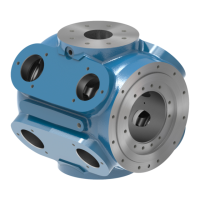FOR MODELS: JGW, JGR AND JGJ
1/01 PAGE 4 - 1
SECTION 4 - LUBRICATION AND VENTING
General
Lubrication performs at least six functions in a compressor:
1. Reduce friction - decreasing friction decreases energy requirement and heat
buildup.
2. Reduce wear - decreasing wear increases equipment life expectancy and
decreases maintenance costs.
3. Cool rubbing surfaces - cooling of rubbing parts maintains working tolerances,
extends oil life, and removes heat from the system.
4. Prevent corrosion - minimization of surface corrosion decreases friction, heat,
and component wear. Generally provided by additives rather than the base lubri-
cant.
5. Seal and reduce contaminant buildup - improves gas seal on piston rings and
packing rings, and flushes away contaminants from moving parts.
6. Dampen shock - shock loads are cushioned, thereby reducing vibration and
noise, and increasing component life.
Lubrication is vital for successful operation of a compressor and deserves special attention
in the package design.
Oil Cooler
All compressors must have an oil cooler. Maximum allowable oil temperature into the com-
pressor frame is 190°F (88°C). The packager is responsible for sizing a proper oil cooler.
Operating conditions which must be taken into account are; the cooling medium, cooling
medium temperature, cooling medium flow rate, lube oil temperature, and lube oil flow rate.
Oil heat rejection data for each frame are shown in the Ariel Data Book in the Frame Details
section (contact your Packager or Ariel when you need this information). The cooler should
be mounted as close to the compressor as possible, with piping of adequate size to mini-
mize pressure drop of both the lubricating oil and the cooling medium.
1. For proper operation of the recommended thermostatic valve, provided as an
option by Ariel, the maximum differential pressure between the hot oil supply
line (point B) and the cooled oil return line (point C) is 10 psi (0.7 bar). Refer to
Figure 4-10: Lube Oil System Schematic - Typical.
2. Ariel recommends installation of the thermostatic valve in the mixing mode.

